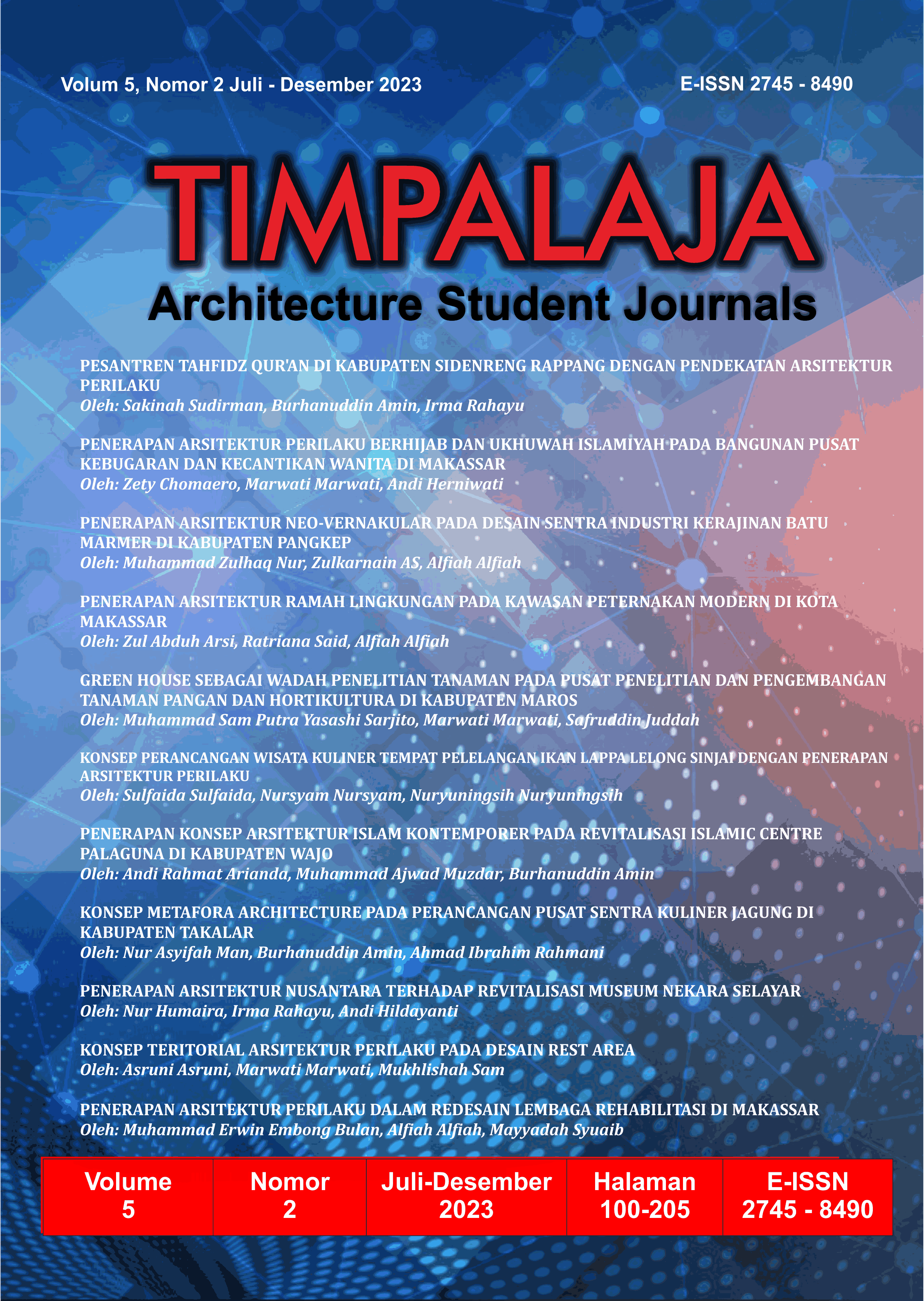Penerapan Arsitektur Eklektik Dalam Perancangan Waterfront Cottage Di Pantai Pasir Putih Papua Barat
Abstract
The Pasir Putih beach tourist attraction in West Papua is a recreational and religious attraction full of historical value, making it a mainstay for tourists visiting West Papua. This tourist attraction offers the natural beauty of its beaches, which are unique in their sea water which has three colors). However, the management aspects of Pasir Putih Beach are still not managed professionally by the government, and there is a lack of awareness among the local community. This design aims to support the existence of the Pasir Putih Beach tourist attraction. As a condition for developing the attractiveness of the tourist attraction, it is necessary to develop facilities that can accommodate every activity for the local community and tourists at the attraction. The design principle of Eclectic Architecture is to combine the styles and elements of traditional Papuan architecture and Scandinavian architecture in building design. The process goes through stages of data analysis and synthesis methods to produce a design for accommodation in the form of a cottage with several supporting facilities such as parks/green open spaces, recreation areas, children's play areas, and beach volleyball sports areas. It is hoped that this design can become a facility that can meet accommodation needs at the Pasir Putih Beach tourist attraction while also increasing its attraction for tourists by using a design that displays the beauty of the past and present in the shape of the building, ornaments, materials and coloring techniques so that it becomes its characteristic, which is different from other tourist attractions.
References
Candra, M. R. et. al. (2018). Penerapan Konsep Scandinavian Pada Interior Bangunan Cottage, Bali. E-Jurnal Arsitektur Universitas Udayana, 3(2).
Christian, Lallo. et. al. (2016). Persepsi Wisatawan Terhadap Fasilitas Infrastruktur Di Pantai Pasir Putih Kabupaten Manokwari Propinsi Papua Barat, 181-188.
Devi, N. S., dan Subiyantoro, H. (2020). Komparasi Penerapan Arsitektur Tradisional Papua Pada Elemen Fasad Resort. … Jurnal Mahasiswa Arsitektur, 1(2), 183–189.
Fauziah, Nur. (2014). Karakteristik Arsitektur Tradisional Papua. Simposium Nasional Teknologi Terapan (SNTT)2 2014, 19–29.
Harisah, A. et. al. (2007). Eklektisisme Dan Arsitektur Eklektik, Prinsip dan Konsep Desain, Gadjah Mada University Press, Yogyakarta.
Hematang, Y. I. P. et. al. (2014). Kearifan Lokal Ibeiya Dan Konservasi Arsitektur Vernakular Papua Barat. Indonesian Journal Of Conservation, Vol. 3. No. 1 – Juni 2014 [ISSN: 2252-9195] Hlm. 16—25.
Meutia, Z. D. (2019). Desain lansekap sebagai mitigasi bencana tsunami. Unimal Press, Banda Aceh.
Haryanto, H. S. (2019). Analisis Bahaya, Kerentanan Dan Risiko Bencana Tsunami Di Provinsi Papua Barat. Jurnal Alami (ISSN: 2548-8635), Vol. 3 No. 1, Tahun 2019.
Nasaningrum, G. O., dan Natalia, D. A. R. (2021). Pendekatan permukiman tradisional papua (silimo) pada perancangan pusat kebudayaan di kabupaten jayapura papua. Jurnal Arsitektur Zonasi Volume 4 – Nomor 3 – Oktober 2021.
Prajnawrdhi, T. A. (2005). Eclecticism Dalam Arsitektur Dalam Tulisan Charles Jenck: Toward Radical Eclecticism. Jurnal Permukiman Natah, vol. 3 No. 2 Agustus 2005: 62 - 101, 2(2005), 62–101. Rauza. (2020). Perancangan recreational waterfront di pesisir pantai ulee lheue (pendekatan mitigasi bencana).
Rumansara. E. H. (2015). Memahami kebudayaan lokal papua : suatu pendekatan pembangunan yang manusiawi di tanah papua. Jurnal Ekologi Birokrasi, Vol.1, No.1. Februari 2015.
Supriyadi, B. (2008). Kajian Waterfront di Semarang. Enclosure, 7(1), 50–58.
Tangkuman, D. J., dan Tondobola, L. (2011). Arsitektur Tepi Air. Media Matrasain, 8(2), 40–54.
Titiheru, N. Y., dan Rogi, Octavianus H. A., (2015). Hotel Resort Di Tanjung Kasuari Sorong “ Arsitektur Eklektik .”, 39–45.
Copyright (c) 2023 Alifia Sekar Wana Kinasih, Irma Rahayu, Andi Hildayanti

This work is licensed under a Creative Commons Attribution-ShareAlike 4.0 International License.
By submitting your manuscript to our journal, you are following Copyright and License







